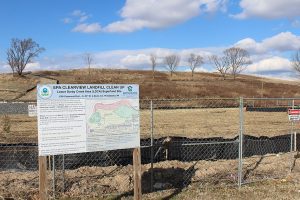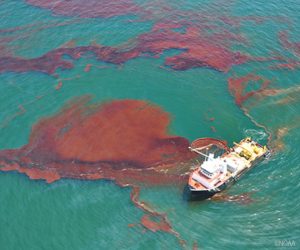Though nearly every country in the world now has laws designed to conserve and protect the environment, environmental law as a field is relatively new. Environmental law first rose to prominence in the United States in the 1960s and 1970s, when popular concern about environmental degradation prompted bipartisan action to codify environmental protections on a federal level. Innovations in U.S. environmental law have served as templates for legal systems around the world.
Below are a few of the most impactful developments in the history of U.S. environmental law. U.S. environmental law now consists of a tapestry of wide-ranging federal statutes, impactful court cases, and state-level action. But the environmental law field is a dynamic one, with new challenges and potential solutions arising every day. Lawmakers, federal agencies, and citizens must work together to create a legal framework that ensures environmental protections now and in the future.
National Environmental Policy Act (NEPA), 1970
As the first comprehensive federal environmental law passed in the United States, NEPA has been called the “magna carta” of environmental law for its influence. NEPA’s statutes require that all actions taken by the federal government, including those conducted by third parties but authorized or permitted by the federal government, must assess environmental impacts as part of their decision-making calculus.

Why Is The National Environmental Policy Act Important?
This concept of environmental review didn’t exist until NEPA was passed. NEPA massively increased transparency on U.S. government actions by requiring a period of public comment on environmental impacts for all major federal actions. Further amendments and agency interpretations have strengthened the Act. Under the Biden administration, environmental assessments must prioritize environmental justice and create enforceable mitigation measures for actions that may be detrimental to the environment.
U.S. Clean Air Act, 1970
First passed in 1963, the Clean Air Act (CAA) became the law as we currently know it with amendments in 1970.
What Did The Clean Air Act Do?
These amendments authorized the EPA to set National Ambient Air Quality Standards (NAAQS) that states must create enforcement measures to achieve. The CAA authorizes the regulation of both stationary sources of air pollution, like power plants, and mobile sources, like cars. Under the CAA, the EPA regulates 187 different air pollutants that have been found to be hazardous to human health.
Further amendments have allowed the Clean Air Act to respond to new air pollution challenges as they arise. The amendments passed in 1990, for example, created a cap-and-trade program to reduce emissions that lead to acid rain. Though acid rain still remains a problem in some parts of the country, its prevalence has diminished as a result of CAA regulations.
Tennessee Valley Authority v. Hill, 1978
When the Endangered Species Act was passed in 1973, it included strict stipulations on how federally authorized actions are allowed to impact endangered species and their habitats. The Tennessee Valley Authority, a federally owned utility company, had nearly completed construction of a dam on the Little Tennessee River when construction was halted by the Department of the Interior on the basis that it would destroy habitat for the endangered snail darter, a tiny fish that lives in eastern Tennessee waters.

When Tennessee Valley Authority v. Hill was decided by the Supreme Court, it was the first major legal test of the provisions of the Endangered Species Act. The court found that it was indeed legal to halt the construction of the dam under the Endangered Species Act’s statutes, setting a precedent that has allowed for more robust protection of countless species across the United States. Today, snail darter populations have recovered enough that the species is no longer listed as endangered—showing that the Endangered Species Act is a powerful tool for conservation.
Clean Water Act of 1972
The Clean Water Act (CWA) arose from amendments to the 1948 Federal Water Pollution Act and represented the first major federal oversight of water pollution in the United States. Most importantly, it outlawed the discharge of pollutants into U.S. waterways without a federal permit and set up state-level monitoring programs for all waterways to ensure compliance. The CWA divides water pollution into two categories: point source pollution, where pollutants can be identified as coming from a single source like a pipe, and nonpoint source pollution, where pollutants are coming from a more uncertain source, like sediment runoff on roads.
The line between point and nonpoint source pollution can be quite nebulous. Pesticides and fertilizer runoff from farms, for example, is considered nonpoint source pollution. These distinctions are especially important in the CWA, where regulations for point source pollution are much more stringent than for nonpoint source pollution. Unsurprisingly, this leaves agricultural pollution as one of the biggest sources of water pollution in the United States.
Laws that Regulate Hazardous Waste
Two laws collectively regulate hazardous substances in the United States – CERCLA and RCRA.
Comprehensive Environmental Response, Compensation, and Liability Act (CERCLA), 1980
CERCLA is also commonly known as “superfund” for its designation of superfund sites, or locations that are significantly contaminated with hazardous substances like former landfills or areas impacted by chemical spills. Most significantly, CERCLA requires that the cleanup of these sites is paid for by the original polluters, even if they have long since stopped actively contributing to a site’s contamination.

Resource Conservation and Recovery Act (RCRA), 1976
RCRA directly regulates hazardous materials themselves, including their production, storage, transportation, and disposal. Penalties and provisions under RCRA are designed to stop future superfund sites from being created in the first place.
Massachusetts v. Environmental Protection Agency, 2007
Most advents in environmental law since 2000 have happened through court cases instead of new laws actively being passed. One of the most impactful of those court cases happened when several states and cities sued the EPA, forcing it to consider a rule that would regulate greenhouse gas emissions under the Clean Air Act. The 5-4 decision by the Supreme Court found that demonstrated harms from climate change gave states the standing to sue, and cleared the way for the EPA to actively regulate pollutants that lead to climate change. The six greenhouse gases that can now be regulated are: carbon dioxide, methane, nitrous oxide, hydrofluorocarbons, perfluorocarbons, and sulfur hexafluoride.
U.S. Environmental Law in the Past and Future
As environmental problems including climate change, habitat loss, and sea level rise continue to accelerate, more and more action will be required in the field of environmental law to keep up with the changing world. Though many more protections are still needed, the great strides made in environmental law in the past 50 years demonstrate just how quickly environmental regulations can pass when there is political will to do so.
Image credits: Signing of NEPA (President Richard Nixon Signing the National Environmental Policy Act is Public domain, via Wikimedia Commons); Snail darter (Snail Darter FWS 1 is Public domain, via Wikimedia Commons); EPA Superfund Signage at the Clearview Landfill (Dwkaminski, CC BY-SA 4.0, via Wikimedia Commons)




